Children & Young People Respite Facility
Context
Akeso supported a Welsh University Health Board and its three Local Authority partners to assess the feasibility of a respite care facility for children and young people (CYP) with complex physical healthcare needs.
Respite provision across the region was fragmented, with long waiting lists, inconsistent service models, significant emotional burden for families and financial strain on the system. The lack of integrated health and social care pathways, coupled with operational pressures such as staffing shortages and limited infrastructure, created barriers to delivering safe, equitable, and sustainable respite care, resulting in family breakdown and reliance on expensive long-term and acute services.
The project delivered a Viability Study and Strategic Outline Case (SOC) for a new facility that would meet clinical needs, deliver value for money, and improve outcomes for children, families and the wider system.
Methodology
Akeso’s approach to the CYP Respite Viability Study was rooted in deep listening, rigorous analysis, and collaborative design. From the outset, we worked in partnership with children, families, clinicians and system leaders to ensure the future respite model was not only clinically safe and financially viable, but also deeply rooted in lived experience. Over a 22-week period, we worked closely the Health Board and its three Local Authority partners to understand the lived realities of families, the operational constraints of current services, and the strategic opportunities for future provision.
Listening First: What Families Told Us
We began by engaging directly with families of children and young people with complex physical healthcare and social care needs; a cohort currently excluded from existing respite services. Through bilingual surveys, focus groups, and one-to-one interviews, we heard powerful stories of exhaustion, isolation, and resilience. Parents described the emotional toll of round-the-clock care, the confusion of navigating fragmented systems, and the urgent need for safe, reliable respite. Children themselves spoke of wanting calm, inclusive spaces where they could feel safe and supported.
Clinician and Staff Insights
We convened workshops with clinical teams, social care professionals and special school staff. These sessions revealed a system under strain: workforce shortages, inconsistent definitions of respite and facilities unable to accommodate clinical complexity.
Data-Driven Design
Population Health Management (PHM) and data analytics were used to forecast service demand and model future capacity requirements. Benchmarking against best-practice models in Greater Manchester, North Yorkshire, and Cheshire helped shape our understanding of what good could look like; small, purpose-built facilities with integrated multidisciplinary teams and therapeutic environments.
Choosing the Best Model
We undertook a comprehensive options appraisal, assessing nine delivery models against strategic fit, quality, feasibility, affordability, and impact. Functional briefs, and schedules of accommodation were co-developed with lived experience from Children and Young People and their families and from clinical nursing specialists. The preferred option offers not just a building, but a blueprint for integrated, preventative care that keeps families together and children safe.
Impact
The recommended solution an 8-bed, purpose-built respite facility, offers a transformative response to a long-standing gap in provision. Our collaborative, multi-disciplinary approach ensured that the preferred option was not only technically robust, but also socially and clinically grounded. It reflects the voices of those who will use it, the expertise of those who will deliver it, and the priorities of those who will fund and govern it.
It will be designed to meet dual registration standards with Health Inspectorate Wales (HIW) and Care Inspectorate Wales (CIW), enabling the very first integrated health and social care delivery model.
The projected benefits are compelling:
saved for every £1 invested
Net present social value over 10 years
Annual savings by preventing family breakdown and long-term placements
per parent per year saved in GP and mental health service usage.
Beyond the numbers the facility will:
1. Reduce parental stress and burnout
2. Enable carers to return to work
3. Improve family stability and wellbeing
4. Offer children and young people a calm, inclusive space with access to care and leisure activities.
This is not just a capital investment; it’s a system-wide intervention that shifts care from reactive to preventative, and from fragmented to integrated.

Contact Our Experts
Rosie Morgan
Manager
Rosie.Morgan@akeso.co.uk